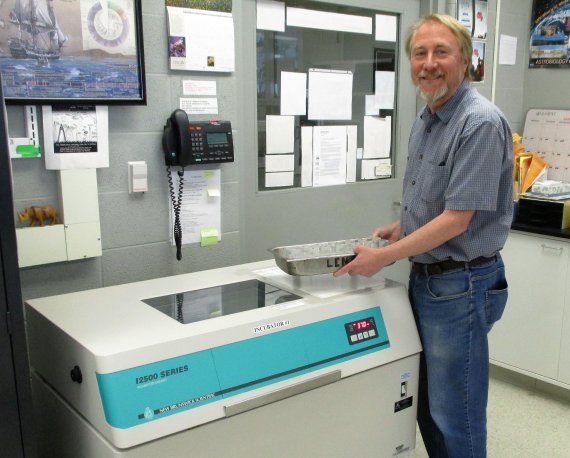© Wikimedia
At first, it doesn’t seem very spectacular. You scrape some bacteria from an agar plate, put them in twelve different flasks and then keep these cultures alive for years under identical conditions. This is what the American biologist Richard Lenski decided to do in 1988. Because the bacteria can reproduce themselves asexually every hour, you very quickly have many generations. Lenski took things slowly with about seven generations a day and he now has flasks and data on 65,000 generations of the twelve populations. From an evolutionary perspective, you might think that 30 years is peanuts, until you realise that Homo sapiens has existed for only about 9,000 generations. ‘This is a long-term evolutionary experiment,’ explained Arjan de Visser, a professor holding a personal Chair at Genetics, who was a post-doc student under Lenski at Michigan State University.
Follow evolution
Lenski, who will speak at the Wageningen Evolution and Ecology Seminar (WEES) on 31 August, opened an entirely new discipline with this research. De Visser: ‘Evolution was always about comparing sorts and putting them into a genealogical tree to clarify the relationships between sorts and their predecessors. You’re always looking backwards. Lenski came up with a new method: you start and follow evolution. This was the beginning of experimental evolutionary biology.’
What does the experiment show us?
De Visser: ‘Lenski discovered that the fitness of the bacteria continues to increase. You’d expect the bacteria to adjust to their surroundings in the first generations and then to remain stable. But no, they continue to adapt.’
‘And you also see differences arise among the twelve populations. The bacteria are growing on a culture consisting of, among other things, glucose and citric acid. One of the populations has learned to break down citric acid and use it as food, this after 30,000 generations. That gave this population a great fitness boost.’
Does WUR also do this type of experiment?
‘Yes, we have the same bacteria populations as Lenski, after 20,000 generations, here in the freezer. We use them for educational purposes. And we also use the E. coli strain for research on resistance to antibiotics. We expose the bacteria to antibiotics and see whether and when the E. coli bacteria produce enzymes to break down the antibiotics. Those are the ESBLs with a resistance to antibiotics. We study this process under controlled circumstances and hope to be able to predict resistance to antibiotics. We still have a long way to go, but we’ve already found diverse mutation routes towards this resistance.’
Does this research provide new insights?
Post-doc Mark Zwart at Genetics: ‘You can see how various mutations of the bacteria compete with one another and that one of them usually wins. The winner dominates for a while, but then a new mutation, a copying error in the bacteria’s DNA, occurs. Those mutations are usually less favourable and die quickly, but sometimes they’re positive.’
Do you see any applications?
De Visser: ‘This is fundamental research to understand the evolution of this bacteria, but we’re also investigation applications for the livestock sector. We’re now doing an experiment with the faculty of Veterinary Medicine in Utrecht, where we’re studying the composition of the E. coli bacteria in the intestines of chickens. We hope to be able to follow and understand the spread of the bacteria gene for antibiotics resistance in chickens. Perhaps our knowledge can help us to find new therapies to reduce this resistance.’
Do other WUR groups also do this sort of research?
De Visser: ‘Definitely. Nutritional microbiologists at Wageningen are studying yoghurt and cheese from Zambia made with fermented milk. During that fermentation process, a number of bacteria strains compete with one another. That’s an ecological process with radical changes in the composition of the bacteria. They want to understand how that process takes place and whether they can reproduce and control it in order to create a uniform product.’
Why is Lenski coming to Wageningen?
‘He had a meeting in the Netherlands and sent me a mail asking if he could stop by in Wageningen. Lenski and WUR know each other: he was also in Wageningen in 2013, when he received an honorary doctorate from the university and gave a seminar. And in 2004 he was a speaker at the Current Themes in Ecology and Evolution symposium in Wageningen.’
Seminar: Dynamics of Adaptation and Genome Evolution in a Long-Term Experiment, by Richard Lenski.
Date: Thursday, 31 August at 4pm
Location: Impulse, Wageningen Campus
Register with:mark.zwart@wur.nl

